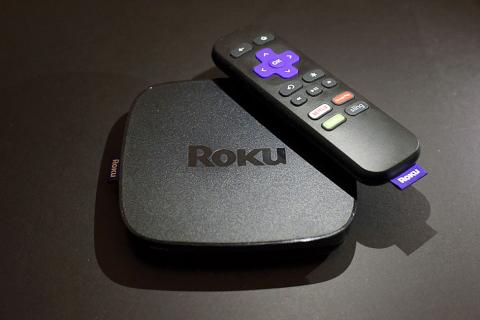Online streaming television pioneer Roku Inc on Friday filed paperwork to raise as much as US$100 million with an offering of stock on the NASDAQ exchange.
Roku was early to the trend of viewers “cutting the cord” and shunning traditional cable television in favor of streaming shows online as desired.
The first-generation Roku streamed Netflix, but its “set-top boxes” have evolved to offer content from an array of providers including Hulu and HBO Now.

Photo: AP
Roku said its branded devices for tapping into the company’s video streaming platform are sold in the UK, Canada, France, Ireland, Mexico and the US.
The Roku app is available more broadly.
Some television makers have built Roku software directly into display screens. Content offerings include subscriptions and shows supported by ads.
Roku and Netflix Inc both have their main offices in the Silicon Valley city of Los Gatos, California.
Roku said in a filing with the US Securities and Exchange Commission that it intended to be traded as ROKU, but did not set a share price.
There were 15.1 million active Roku accounts at the end of June, and users of the service streamed more than 6.7 billion hours of video in the first six months of the year, the company said in the filing.
Roku is the top television streaming platform in the US as measured by total hours streamed.
Roku reported revenue of US$199.7 million in the first half of this year, an increase of 23 percent from the same period last year.
Meanwhile, the company’s net loss shrank to US$24.2 million in the six months which ended on June 30 from US$33.2 million during the same period last year.
“Our mission is to be the TV streaming platform that connects the entire TV ecosystem,” Roku founder and chief executive Anthony Wood said in a letter included in the filing.
“I believe that just like mainframeoperating systems didn’t transition to PCs, and just like PC operating systems didn’t make the transition to phones (is your phone powered by Windows?), TVs will be powered by a purpose-built operating system optimized for streaming,” he added.

Zhang Yazhou was sitting in the passenger seat of her Tesla Model 3 when she said she heard her father’s panicked voice: The brakes do not work. Approaching a red light, her father swerved around two cars before plowing into a sport utility vehicle and a sedan, and crashing into a large concrete barrier. Stunned, Zhang gazed at the deflating airbag in front of her. She could never have imagined what was to come: Tesla Inc sued her for defamation for complaining publicly about the vehicles brakes — and won. A Chinese court ordered Zhang to pay more than US$23,000 in

Taiwan Semiconductor Manufacturing Co (TSMC, 台積電) yesterday said that its investment plan in Arizona is going according to schedule, following a local media report claiming that the company is planning to break ground on its third wafer fab in the US in June. In a statement, TSMC said it does not comment on market speculation, but that its investments in Arizona are proceeding well. TSMC is investing more than US$65 billion in Arizona to build three advanced wafer fabs. The first one has started production using the 4-nanometer (nm) process, while the second one would start mass production using the

US President Donald Trump has threatened to impose up to 100 percent tariffs on Taiwan’s semiconductor exports to the US to encourage chip manufacturers to move their production facilities to the US, but experts are questioning his strategy, warning it could harm industries on both sides. “I’m very confused and surprised that the Trump administration would try and do this,” Bob O’Donnell, chief analyst and founder of TECHnalysis Research in California, said in an interview with the Central News Agency on Wednesday. “It seems to reflect the fact that they don’t understand how the semiconductor industry really works,” O’Donnell said. Economic sanctions would

‘NO DISRUPTION’: A US trade association said that it was ready to work with the US administration to streamline the program’s requirements and achieve shared goals The White House is seeking to renegotiate US CHIPS and Science Act awards and has signaled delays to some upcoming semiconductor disbursements, two sources familiar with the matter told reporters. The people, along with a third source, said that the new US administration is reviewing the projects awarded under the 2022 law, meant to boost US domestic semiconductor output with US$39 billion in subsidies. Washington plans to renegotiate some of the deals after assessing and changing current requirements, the sources said. The extent of the possible changes and how they would affect agreements already finalized was not immediately clear. It was not known